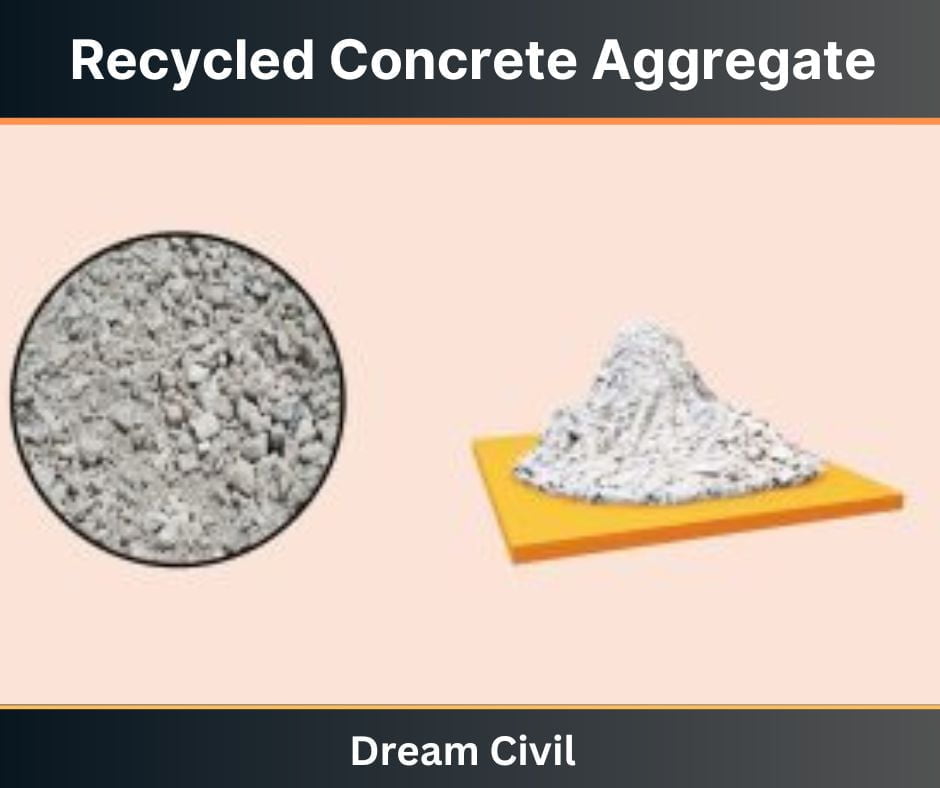Table of Contents
Recycled concrete aggregate is also known as Crushed concrete aggregate.
It is an alternative to using waste concrete having a low amount of dust particles or building waste. The building waste must be less than a few percent.
The waste concrete having natural aggregate is used in retaining work, and foundation work as filling material.
The mining will be reduced due to the use of recycled concrete. The use of recycled concrete will reduce the cost of the structure.

1. Uses of Recycled Concrete Aggregate
a. It delivers a low-cost alternative solution to thrashing natural raw materials.
b. Recycled concrete aggregate creates projects sustainable.
c. Concrete constructed with crushed concrete aggregate has a less carbon footprint.
d. It decreases the natural aggregate shortage.
e. Bears less energy than mining new.
f. Recycled concrete aggregate helps to decrease the construction cost.
| Read Also: Concrete Edging |
2. Properties of Recycled Concrete Aggregate
The properties of recycled concrete aggregate are as follows:
a. Density
The density of recycled concrete aggregate is less than the natural aggregate density.
b. Water absorption
The water-absorbing capacity of crushed aggregate is greater than that of natural aggregate. Water absorption is one of the most important characteristics that differentiate recycled aggregate from raw aggregates.
Water absorption of recycled aggregate influences both new and hardened concrete properties. Recycled sand will be neglected, due to its absorption capacity, which would not produce a shrinkage effect.
The workability of crushed aggregate concretes is influenced by the absorption capacity of the crushed aggregates.
c. Contaminants
The presence of contaminants in crushed aggregate decreases the strength of concrete produced with this aggregate.
d. Los Angeles Abrasion Loss
Crushed concrete aggregate conforms with ASTM international with regard to Los Angeles abrasion loss.
e. Size of Aggregate
Crushed concrete shall be processed to reach suitable sizes. The crushing method which can be mechanical or manual of concrete to make coarse aggregate for the preparation of new concrete is one of the elements that affect the strength of the concrete.
It is noted that coarse aggregate which complies with criteria can be made. However, fine aggregates are larger and more angular than those used for concrete production.
Consequently, concrete produced with crushed concrete aggregate tends to be harsh and unworkable. Adding a portion of natural sand would tackle this problem. Recycled concrete aggregate can be used without washing.
Eventually, the crushing method and the dimension of the recycled aggregate have an impact on the quantity of stuck mortar.
f. Creep
The creep of concrete delivered from recycled concrete aggregate is higher than concrete formed using natural aggregate by 30 to 60%.
g. Permeability
The permeability of concrete formed from crushed aggregate is greater than that of concrete made with natural aggregate.
h. Drying Shrinkage
The drying shrinkage of concrete produced from crushed aggregate is more than concrete prepared by utilizing natural aggregate.
The percentage of drying shrinkage soars if it is made from recycled coarse and fine aggregate.
i. Modulus of elasticity
The modulus of elasticity of concrete made with recycled coarse and fine aggregate is lower than that of concrete made with a recycled coarse aggregate only.
3. Advantages of Recycled Concrete Aggregate
The advantages of recycled concrete aggregate are as follows:
1. Decreases the cost of construction.
2. Preserve natural resources.
3. It is a high water absorption capacity.
4. It is regarded as green construction material.
4. Disadvantages of Recycled Concrete Aggregate
1. It downgrades the quality of concrete.
2. Workability of concrete is decreased.
3. It has lesser durability.
4. It has less compressive strength.
5. Modulus elasticity is less than that of natural aggregate.
5. References1. Content Filter & Authenticity Checking Team, Dream Civil International (Our team checks every content & detail to maintain quality.) |
| Read More: Neo Concrete |

